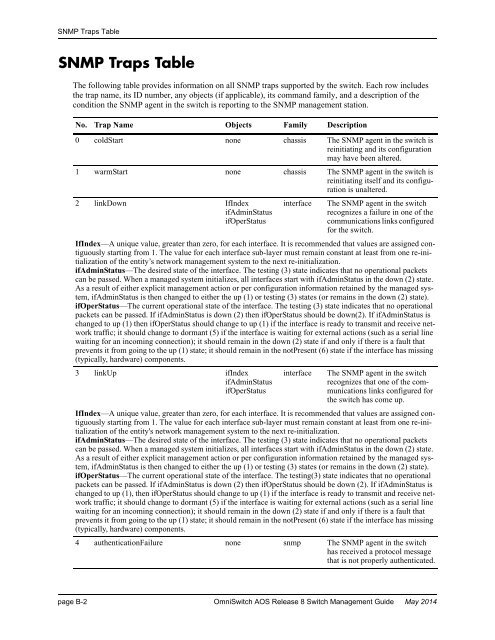OS6860(E)_AOS_8.1.1.R01_Switch_Management_Guide
Create successful ePaper yourself
Turn your PDF publications into a flip-book with our unique Google optimized e-Paper software.
SNMP Traps Table<br />
SNMP Traps Table<br />
The following table provides information on all SNMP traps supported by the switch. Each row includes<br />
the trap name, its ID number, any objects (if applicable), its command family, and a description of the<br />
condition the SNMP agent in the switch is reporting to the SNMP management station.<br />
No. Trap Name Objects Family Description<br />
0 coldStart none chassis The SNMP agent in the switch is<br />
reinitiating and its configuration<br />
may have been altered.<br />
1 warmStart none chassis The SNMP agent in the switch is<br />
reinitiating itself and its configuration<br />
is unaltered.<br />
2 linkDown IfIndex<br />
ifAdminStatus<br />
ifOperStatus<br />
interface<br />
The SNMP agent in the switch<br />
recognizes a failure in one of the<br />
communications links configured<br />
for the switch.<br />
IfIndex—A unique value, greater than zero, for each interface. It is recommended that values are assigned contiguously<br />
starting from 1. The value for each interface sub-layer must remain constant at least from one re-initialization<br />
of the entity’s network management system to the next re-initialization.<br />
ifAdminStatus—The desired state of the interface. The testing (3) state indicates that no operational packets<br />
can be passed. When a managed system initializes, all interfaces start with ifAdminStatus in the down (2) state.<br />
As a result of either explicit management action or per configuration information retained by the managed system,<br />
ifAdminStatus is then changed to either the up (1) or testing (3) states (or remains in the down (2) state).<br />
ifOperStatus—The current operational state of the interface. The testing (3) state indicates that no operational<br />
packets can be passed. If ifAdminStatus is down (2) then ifOperStatus should be down(2). If ifAdminStatus is<br />
changed to up (1) then ifOperStatus should change to up (1) if the interface is ready to transmit and receive network<br />
traffic; it should change to dormant (5) if the interface is waiting for external actions (such as a serial line<br />
waiting for an incoming connection); it should remain in the down (2) state if and only if there is a fault that<br />
prevents it from going to the up (1) state; it should remain in the notPresent (6) state if the interface has missing<br />
(typically, hardware) components.<br />
3 linkUp ifIndex<br />
ifAdminStatus<br />
ifOperStatus<br />
interface<br />
The SNMP agent in the switch<br />
recognizes that one of the communications<br />
links configured for<br />
the switch has come up.<br />
IfIndex—A unique value, greater than zero, for each interface. It is recommended that values are assigned contiguously<br />
starting from 1. The value for each interface sub-layer must remain constant at least from one re-initialization<br />
of the entity's network management system to the next re-initialization.<br />
ifAdminStatus—The desired state of the interface. The testing (3) state indicates that no operational packets<br />
can be passed. When a managed system initializes, all interfaces start with ifAdminStatus in the down (2) state.<br />
As a result of either explicit management action or per configuration information retained by the managed system,<br />
ifAdminStatus is then changed to either the up (1) or testing (3) states (or remains in the down (2) state).<br />
ifOperStatus—The current operational state of the interface. The testing(3) state indicates that no operational<br />
packets can be passed. If ifAdminStatus is down (2) then ifOperStatus should be down (2). If ifAdminStatus is<br />
changed to up (1), then ifOperStatus should change to up (1) if the interface is ready to transmit and receive network<br />
traffic; it should change to dormant (5) if the interface is waiting for external actions (such as a serial line<br />
waiting for an incoming connection); it should remain in the down (2) state if and only if there is a fault that<br />
prevents it from going to the up (1) state; it should remain in the notPresent (6) state if the interface has missing<br />
(typically, hardware) components.<br />
4 authenticationFailure none snmp The SNMP agent in the switch<br />
has received a protocol message<br />
that is not properly authenticated.<br />
page B-2 Omni<strong>Switch</strong> <strong>AOS</strong> Release 8 <strong>Switch</strong> <strong>Management</strong> <strong>Guide</strong> May 2014



